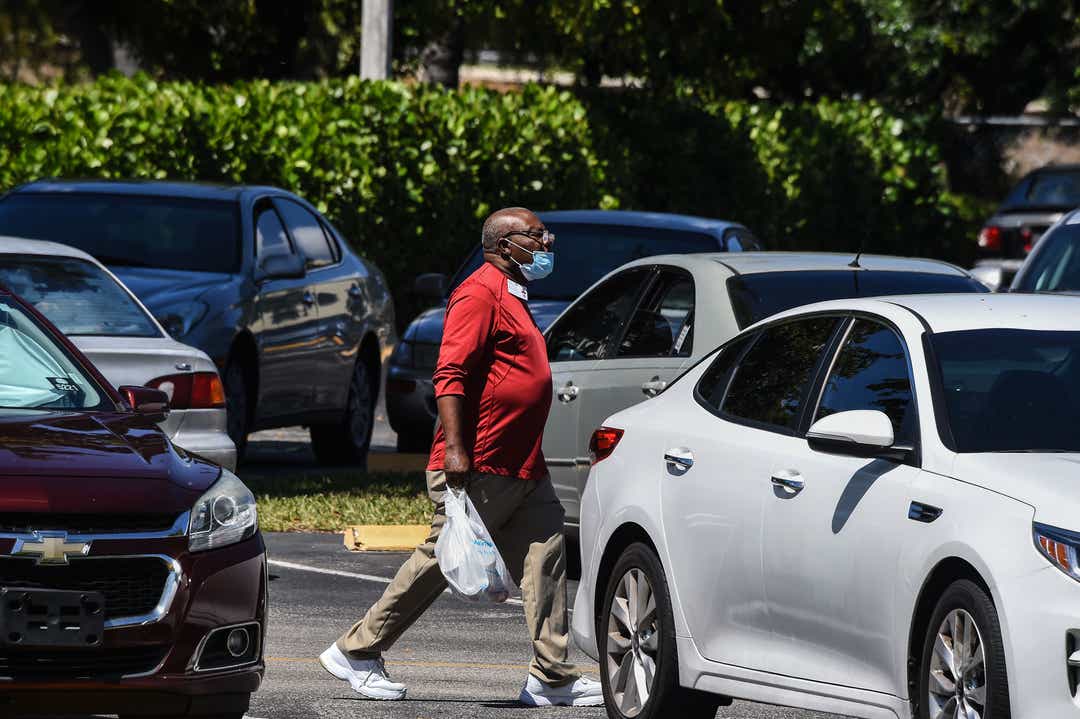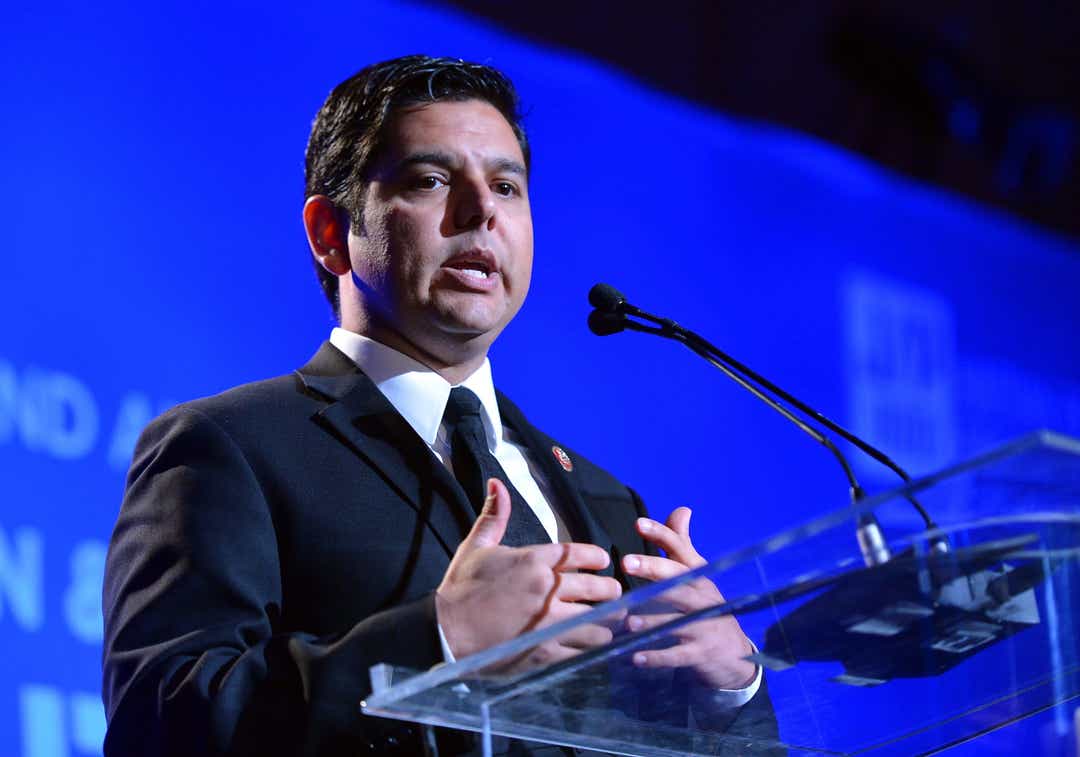Health issues for blacks, Latinos and Native Americans may cause coronavirus to ravage communities

An elderly man covers his face with a mask as he picks up his lunch at John Knox Village,
a retirement community in Pompano Beach some 40 miles north of Miami, Florida on March 21, 2020.
Deborah Barfield Berry USA TODAY
Published 11:46 AM EDT Mar 30, 2020
WASHINGTON — Blacks, Latinos and Native Americans have many underlying health conditions, including asthma and heart disease, that could make them more vulnerable to complications from the coronavirus, leaving advocates, lawmakers and public health experts worried these long marginalized communities won’t get equal access to tests and treatment as the outbreak spreads.
“The virus is an equal opportunity crisis … but the impact and the burden of it is not going to be shared equally,’’ said Dr. Ashwin Vasan, a public health expert and assistant professor at Columbia University in New York City. “Like most things in society, it’s going to be regressive. It’s going to be felt disproportionately by the poor, the vulnerable, the marginalized and obviously that falls down in this country on communities of color.’’
As the coronavirus continues to spread across the country, advocates and civil rights groups are pushing to get local and federal lawmakers to focus attention on communities of color and steer resources to places like reservations and community health centers that serve them.
Some are calling for federal officials to track the number of people of color who have died from coronavirus and to set up a commission to study how coronavirus is spreading in those communities.
There were more than 140,000 confirmed cases of coronavirus in the U.S. by Monday morning and more than 2,500 deaths. Officials have so far not released information on race and coronavirus cases.
“You need to do this with intention,” said Vasan, who is also president & CEO of the mental health charity Fountain House based in New York City. “You need to map out which communities are already at the margins of care and resources and testing and already have preconditions, disproportionate health conditions, and then say, ‘All right, how do we ensure that we’re going there?’”

Samantha Green, left, walks her daughter Madison Green, a five-year-old kindergartner
, to their car as school ends for the day Monday, March 16, 2020, at Roosevelt Elementary in Spokane
, Washington. Officials said schools will be closed to help curb the spread of coronavirus.Tyler Tjomsland, AP
Long history of health disparities
Long before the pandemic, people of color have experienced racial and ethnic health disparities, including a lack of access to quality care and health insurance, public health experts said. Federal agencies, as well as nonprofit health organizations, have studied the issue and set up programs to address it.
The coronavirus outbreak is a stark reminder of those gaps, advocates said.
“It further shines a light on the long standing inequities that exist in society,’’ said J. Nadine Gracia, executive vice president and CEO at Trust For America’s Health, a public health policy group in Washington, D.C.
U.S. Rep. Robin Kelly, chairwoman of the Congressional Black Caucus Health Braintrust, said communities of color tend to be hardest hit by health crises because they tend to have less wealth than whites and less access to health care.
“We’re very concerned because, as we like to say, when the majority gets a cold, we get the flu or we get pneumonia,’’ said Kelly, a Democrat from Illinois.
While the Affordable Care Act helped many people of color get health coverage, many still don’t have insurance, or access to providers and quality care, experts said. According to the Census, 8.5 percent of whites were uninsured in 2017, compared to 10.6 percent of blacks, 7.3 percent for Asians and 16.1 percent for Hispanics.
Dr. Melissa Clarke, former assistant dean in the Howard University College of Medicine in Washington, D.C., said the nation’s history of health disparities and the stressors faced by people of color, including racism and poverty, are factors in those communities disproportionately having the “very diseases that COVID19 presents a problem for.”
Those include high blood pressure, diabetes, heart disease, lung diseases, including asthma and chronic bronchitis, and autoimmune diseases like lupus – all disproportionately found in blacks, Latinos and Native Americans.
Clarke said it’s not that people of color are more vulnerable to getting the virus, but they’re more vulnerable to having more severe manifestations, which can lead to hospitalization and death. In addition to the elderly, people at risk for serious health risks and death from coronavirus have underlying conditions, including hypertension, diabetes, cardiovascular disease, chronic respiratory disease and cancer.
African Americans were 60 percent more likely to be diagnosed with diabetes and twice as likely as non-white Hispanics to die from it, according to the federal Department of Health and Human Services Office of Minority Health. American Indians/Alaska Natives were three times more likely to have diabetes and 2.5 times more likely to die from it. Hispanics, meanwhile, were 1.7 times more likely to have diabetes and 1.4 times more likely to die.
Clarke, author of “Excuse Me Doctor! I’ve Got What?”, said many studies have found bias in the health care system and she’s worried about some medical professionals minimizing symptoms when people of color seek care.
“I’m concerned about that day, God forbid we get to that in this county, where choices have to be made about who gets a ventilator,” she said
More: Coronavirus layoffs disproportionately hurt black and Latino workers: ‘It’s almost like doomsday is coming’
More: 5 maps show how states differ on protecting Americans against coronavirus
People of color could also be more at risk because of their professions, such as anyone working in retail, construction or other jobs that can’t work from home. Meanwhile, health care jobs, including personal care aides and practitioners, are among the top 10 jobs with a high concentration of African Americans, said Shaomeng Jia, an economics professor at Alabama State University’s College of Business Administration.
Those jobs, he said, will likely be in high demand in upcoming weeks and months.
‘People are getting sick, too many people are dying’
Kelly and other members of the Congressional Black Caucus recently sent a letter to House Speaker Nancy Pelosi urging her to push to make sure emergency legislation to address the outbreak includes more resources for tests and equipment for community health centers and local hospitals.
President Donald Trump signed a historic $2 trillion emergency package Friday, the largest in U.S. history. It would expand unemployment benefits and provide direct payments of up to $1,200 for many individuals. Thousands of people who work in restaurants, hotels and small businesses have lost their jobs.

ep. Raul Ruiz, D-Calif., — a former emergency room doctor — speaks during a January charity event in Los Angel
Alberto E. Rodriguez, Getty Images
“It’s still not everything we want,’’ said Kelly. “But we can’t keep delaying because people are getting sick. Too many people are dying. The states don’t have what they need. Small businesses are suffering.”
Rep. Raul Ruiz, D-Calif., an emergency room physician, said it’s important to put more money into underfunded health programs that serve minority communities, such as Medicaid and community health centers.
Those extra resources, he said, “will help relieve some of the disparities in access to testing, access to physicians and care.”
Ruiz is turning to social media, doing public service announcements and appearing on radio and television to answer questions about the coronavirus in English and Spanish. He also hosted a tele-town hall in Spanish Thursday. He took a similar approach during the H1N1 outbreak in 2009. This time, he said, it’s worse.
“We don’t have clear signs like the influenza,’’ he said, because people can transmit the virus without showing symptoms. “So with this it’s even more important to do community engagement in a way that’s culturally relevant and in a language that they can understand.”
Gracia, from Trust For America’s Health, said it’s important that information shared with communities of color is culturally and linguistically appropriate and that it comes from trusted sources, such as faith-based groups.
“There is also mistrust that exists that can also impede access to information and access to care,” she said.
Advocates said neither the Trump administration or Congress have talked enough about health inequities and how they might impact communities of color during the outbreak.
“They can’t even get their act together to identify that the coronavirus was a national health security threat early enough to mobilize the testing, the equipment and the education aggressively early on to protect the general public, nonetheless to consider the underserved rural areas of our country,’’ Ruiz said. “I think that they’re figuring it out as they go and that is not where you want to be during a disaster.”
More: Coronavirus is slowing down search for census workers, could make it harder to count Americans
More: People with disabilities are afraid they will be denied health care because of coronavirus
‘A recipe for disaster’
Experts said one of the most vulnerable groups is Native Americans.
Kevin Allis, CEO of the National Congress of American Indians, said more people were testing positive for coronavirus in Indian Country. He said leaders expect there will soon be even more cases.
“All of us are struggling to figure out what that real number is,’’ he said.

Individuals are tested for COVID-19, also known as the coronavirus at a mobile clinic set up in the parking lot at the Mayo Clinic Hospital in Phoenix on the morning of March 18, 2020. Only Mayo Clinic patients with a doctor’s order could use the mobile clinic. A slow but steady stream of vehicles was passing through the mobile clinic on Wednesday morning.David Wallace, The Republic/ USA TODAY NETWORK
Many reservations are in rural areas and three to four hours away from major health facilities where people can be tested, Allis said.
‘’So we can only imagine what the hurdles, the challenges are getting testing out to these folks,” he said.
Experts say it doesn’t help that there’s deep distrust of the federal government and that Native Americans have long been overlooked for everything from health care to housing.
Native Americans are also disproportionately plagued by heart disease, respiratory illnesses and liver disease and other health ailments, experts said.
For example, American Indians/Alaska Natives were 50 percent more likely to be diagnosed with coronary heart disease compared with whites in 2018, according to the Office of Minority Health.
“There’s no surprise when you see these health disparities that are off the charts, then when you get something like COVID-19 that rolls into these neighborhoods, these reservation communities, it can be really bad,’’ said Allis, a tribal member of the Forest County Potawatomi community in Wisconsin.
Those health conditions combined with health disparities and overcrowding (in many cases generations, including tribal elders, live in a household), make for “a recipe for disaster,” Allis said.
Ruiz, a member of the House Energy and Commerce Subcommittee on Health, said he wrote the administration asking that it provide resources and equipment, including masks and ventilators, and tests for reservations. He said he wanted to make sure tribes on rural reservations “are not an afterthought.”
Ruiz said he also pushed to add funding in the stimulus package for free testing for tribal members, even at facilities off the reservation. The package includes more than $1 billion dollars for Indian Health Services and $453 million for the Bureau of Indian Affairs, Ruiz said.
Vasan said as with any epidemic, officials can’t afford to ignore marginalized communities.
“If you don’t go bring resources to them, then they’re going to be left out of this, and it could very well swing through their communities,’’ he said. “So we’ve got to make it easy. We’ve got to make it really user friendly, culturally competent, and accessible to people. We’ve got to do it now.”
Source:eu.usatoday.com/story/news

